Dental implant surgery is a life-changing procedure that can restore both your smile and your confidence. However, the success of your dental implant doesn’t solely depend on the skill of your dentist — it also depends on how well you take care of your implant after the surgery. One of the most critical aspects of post-operative care is what you eat.
While you may feel tempted to return to your regular meals shortly after surgery, choosing the wrong foods can delay healing, cause discomfort, or even lead to implant failure.
In this article, we’ll explore exactly what foods to avoid after dental implant surgery and explain why a proper diet matters for a smooth recovery.
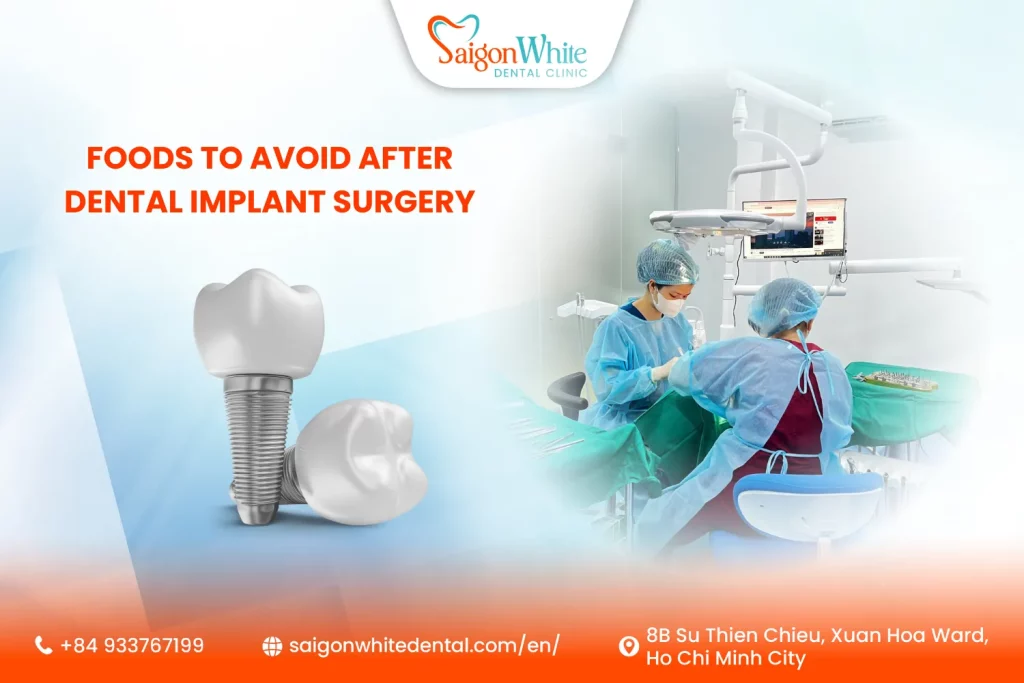
Understanding the Healing Process
Before diving into what not to eat, it’s important to understand what happens in your mouth after a dental implant procedure. Your body goes through several stages of healing:
1. Immediate Healing Phase (0–48 Hours)
What happens:
- After surgery, your body’s first response is to form a blood clot at the surgical site.
- This clot acts as a natural bandage, protecting the underlying bone and gum tissues from bacteria, trauma, or external debris.
- The surrounding area will likely be swollen, tender, and slightly bruised.
Why diet matters:
- Disrupting the clot can lead to bleeding, dry socket-like pain, or infection.
- Hot, spicy, hard, or acidic foods can irritate or dissolve the clot.
- Chewing at this stage may open the wound and delay the natural sealing of soft tissue.
2. Soft Tissue Healing Phase (Days 3–14)
What happens:
- The gum tissue around the implant begins to regenerate and close over the surgical site.
- Inflammation starts to reduce, but the area remains sensitive and vulnerable.
- Some stitches (if used) begin to dissolve, and the healing cap over the implant protects the inner post.
Why diet matters:
- Any physical pressure or food particles caught around the implant can irritate soft tissue and lead to inflammation or infection.
- Sticky, chewy, or crunchy foods can interfere with the closure process or dislodge the protective healing cap.
- Proper nutrition supports collagen production, which is essential for gum regeneration.
3. Osseointegration Phase (Weeks 2–12 or longer)
What happens:
- Osseointegration is the process where the titanium implant fuses with your jawbone, creating a strong, stable foundation for your future crown or bridge.
- This stage is invisible but vital. It determines the long-term success of the implant.
Why diet matters:
- Although you may feel better, the implant is still not fully anchored in bone.
- Biting or chewing hard foods too early can microscopically shift the implant and weaken the bone-implant connection.
- Nutrient-dense, soft foods rich in calcium, vitamin D, protein, and magnesium support bone regeneration.
4. Final Recovery and Functional Loading (After ~3 Months)
What happens:
- Once the implant has fully integrated, your dentist will place the final restoration (crown, bridge, or denture).
- You can gradually return to normal eating habits if your healing has gone smoothly.
Why diet still matters:
- While the implant is stable, the surrounding tissue and jawbone still adapt to pressure from biting and chewing.
- You may still need to avoid extreme foods (very hard or sticky) for a few more weeks or longer, especially for multiple implants or complex cases.
During these phases, the implant site is vulnerable. Chewing hard, sticky, or irritating foods can damage soft tissue, disrupt the blood clot, introduce bacteria, or stress the implant before it’s securely anchored in bone.
Top Categories of Foods to Avoid (With Examples)
1. Crunchy Foods
Crunchy foods may seem harmless, but they’re a major threat after surgery.
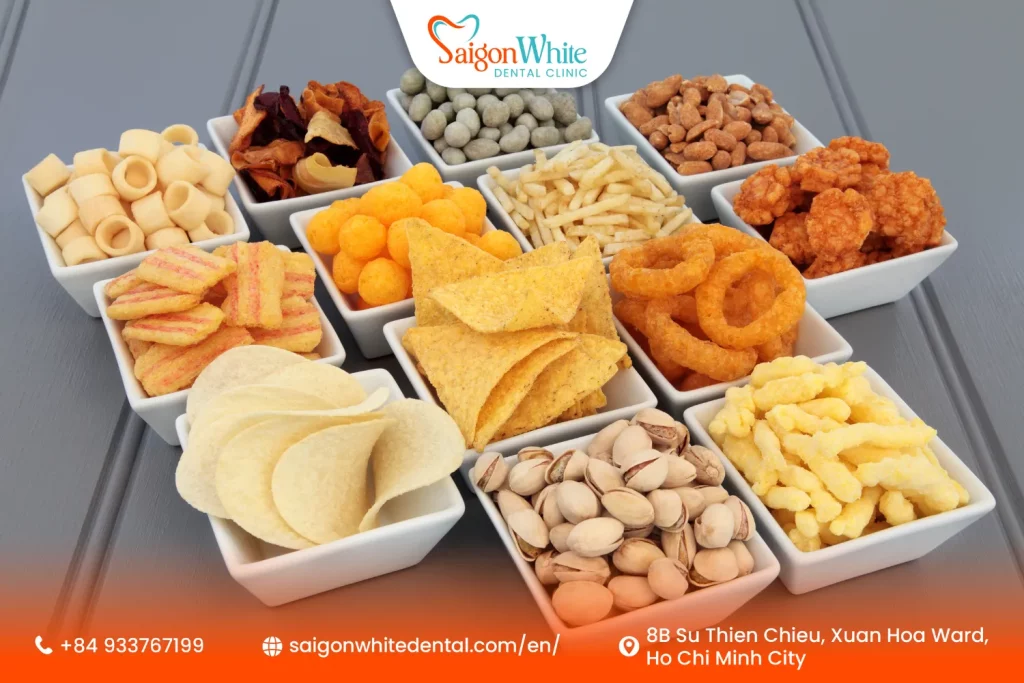
- Examples: Corn chips, pretzels, popcorn, granola, toasted bread, raw vegetables.
- Why Avoid: Their sharp edges can scrape or puncture healing gums. Tiny particles may also get trapped around the implant site, leading to infection or irritation.
2. Hard Foods
Anything that requires a significant bite force should be strictly avoided.
- Examples: Nuts, candy, ice cubes, hard fruits (like apples or pears), raw carrots.
- Why Avoid: Hard foods can apply pressure on the implant site and surrounding bone. This pressure may disturb the placement or integration of the implant, resulting in failure or bone loss.
3. Sticky Foods
Sticky foods are notorious for dislodging stitches and implant covers.
- Examples: Caramel, chewing gum, taffy, rice cakes, sticky buns.
- Why Avoid: Sticky foods can cling to the implant or surrounding gums, pulling at the surgical site and increasing the risk of bleeding, swelling, or wound reopening.
4. Chewy Meats
Tough, chewy proteins may seem like good recovery food due to their nutrients, but they’re often too difficult to manage after surgery.
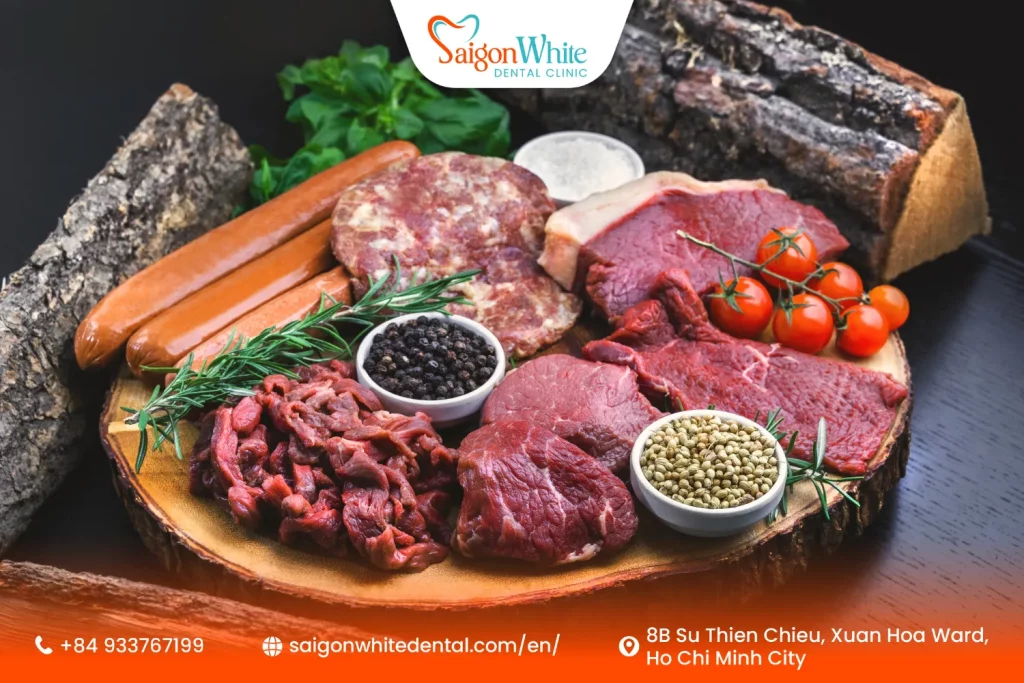
- Examples: Steak, jerky, grilled chicken with skin, ribs.
- Why Avoid: These meats require extensive chewing, which can irritate the implant site and strain the jaw, especially when it’s already sore.
5. Spicy and Acidic Foods
Foods with strong flavors or acidity can inflame or burn healing tissue.
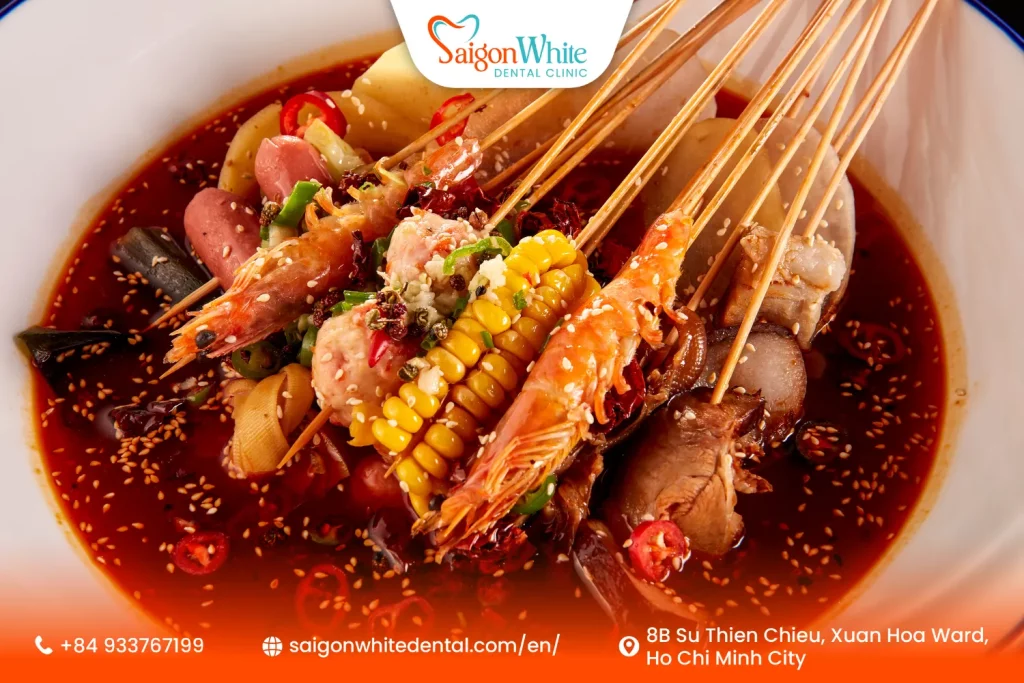
- Examples: Hot sauce, chili peppers, salsa, lemon juice, vinegar, citrus fruits.
- Why Avoid: These irritants can delay gum healing and cause pain. Acidic foods may also erode delicate tissues around the implant.
6. Sugary Snacks and Beverages
Sugar feeds harmful bacteria, which is the last thing your healing mouth needs.
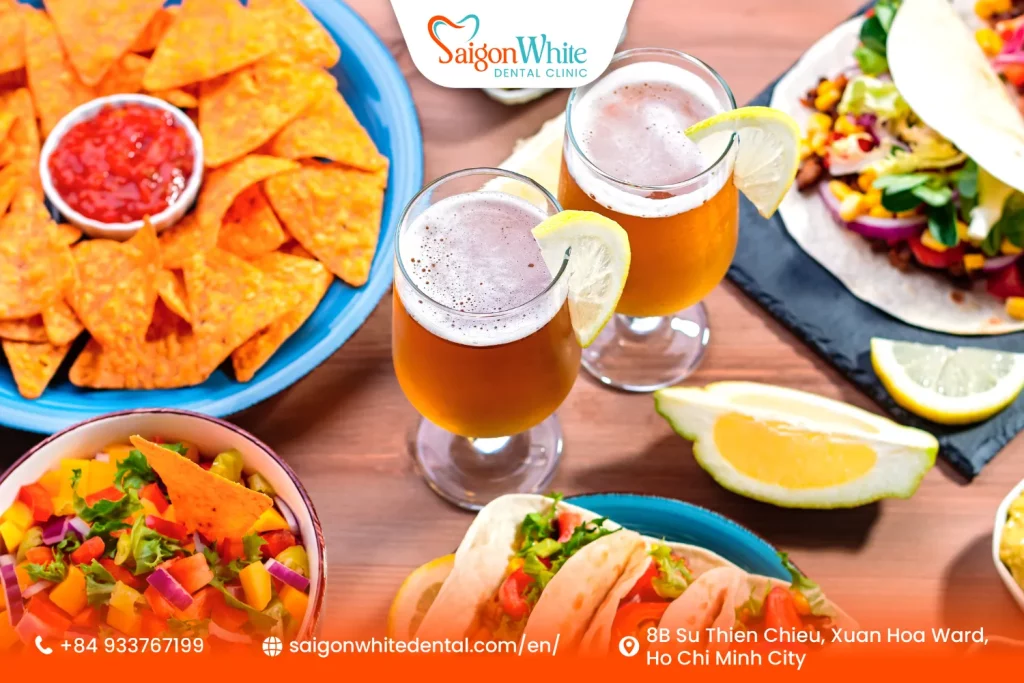
- Examples: Soda, candy, sweetened tea, cookies, pastries.
- Why Avoid: Excess sugar increases the risk of gum infection and peri-implantitis — a condition that may lead to implant failure if not treated promptly.
7. Hot Foods and Drinks
Many people don’t realize how much heat can affect recovery.

- Examples: Hot coffee, tea, soup, pizza fresh from the oven.
- Why Avoid: High temperatures can dissolve the blood clot or increase swelling. Burns inside the mouth can also lead to infection or delay wound closure.
8. Alcoholic Beverages
While it might be tempting to celebrate your new smile with a drink, don’t.

- Examples: Beer, wine, spirits.
- Why Avoid: Alcohol dehydrates your body, interferes with medication, and slows healing. It may also increase bleeding or prevent clot formation.
Foods to Avoid Based on Recovery Timeline
Healing from dental implant surgery isn’t just about avoiding certain foods — it’s about timing. Your mouth goes through different phases of recovery, and each phase comes with its own set of dietary restrictions and recommendations. Below is a detailed breakdown of what foods to avoid and why, based on the typical healing timeline.
Days 1–3: The Critical Healing Window
What’s happening:
- A blood clot forms around the implant site to protect the wound and begin healing.
- Gums are swollen, tender, and vulnerable to disturbance.
- Any disruption at this stage can lead to complications like dry socket, bleeding, or infection.
Foods to strictly avoid:
- Hot foods & beverages: Hot soup, coffee, tea – these can dissolve or dislodge the clot.
- Crunchy or grainy foods: Chips, popcorn, seeds – small particles can enter the wound.
- Chewy or tough foods: Meats, bread crust – may stress the jaw or dislodge clots.
- Drinking through a straw creates suction, which can dislodge the clot and delay healing.
- Citrus or acidic items: Orange juice, tomatoes – irritate tissue and increase pain.
- Spicy foods: Hot sauce, pepper – can burn and inflame soft tissue.
Recommended foods:
- Lukewarm soups (pureed)
- Smoothies (without a straw)
- Mashed potatoes
- Applesauce
- Yogurt
Tip:
Keep food cold or at room temperature, and avoid chewing completely if possible.
Days 4–7: Soft Tissue Stabilization
What’s happening:
- Gum tissue begins closing, and inflammation reduces.
- The implant is still fragile, but minor chewing may be introduced on the opposite side.
Foods to still avoid:
- Tough meats: Steak, jerky, pork chops.
- Hard snacks: Nuts, crackers, baguettes.
- Sticky sweets: Caramel, toffee, chewing gum – may pull stitches or irritate the wound.
- Spicy or acidic foods: Still too harsh on the sensitive gum area.
- Sugary snacks: Increase bacterial growth in healing gums.
Recommended foods:
- Scrambled eggs, soft-boiled fish, steamed tofu
- Avocado, mashed banana
- Well-cooked pasta or rice
- Soft oatmeal
- Lukewarm herbal teas and bone broth
Tip:
Continue chewing on the non-implant side and avoid putting pressure on the implant site.
Week 2 to Week 4: Transition to Normal Diet Begins (Cautiously)
What’s happening:
- Sutures may dissolve or be removed.
- Soft tissue mostly healed, but osseointegration (bone bonding) is still in progress.
Foods to still avoid:
- Hard foods: Ice, hard candy, crusty pizza.
- Chewy textures: Cheese sticks, tough bread, sticky rice cakes.
- Greasy or processed fast foods may lead to inflammation and poor nutrition.
- Alcohol: Can delay healing and dehydrate tissue.
Recommended foods:
- Soft sandwiches (cut into small bites)
- Soft-cooked vegetables (zucchini, spinach, pumpkin)
- Cooked lentils, beans, or chickpeas
- Poached chicken or fish
- Soft fruits without skin
Tip:
Check with your dentist before returning to foods that require normal chewing. Healing rates vary between patients.
Month 1 and Beyond: Gradual Return to Normal Eating
What’s happening:
- The implant begins fusing securely to the bone.
- You may feel more comfortable, but that doesn’t mean you’re fully healed yet.
Foods to introduce cautiously (under guidance):
- Crunchy fruits and vegetables (e.g., apples, cucumbers) — cut into small pieces first.
- Lean meats — only when soft and easy to chew.
- Lightly toasted bread — avoid crusty or hard edges.
- Firm cheeses — small, manageable bites.
Still avoid:
- Biting directly into hard or sticky foods.
- Chewing gum or candy on the implant side.
- Raw, fibrous vegetables should be steamed or softened.
- Unwashed or seeded fruits (risk of infection from bacteria or particles).
Tip:
Always maintain excellent oral hygiene and regular check-ups to monitor implant integration.
Summary Table: Foods to Avoid by Phase
| Timeframe | Foods to Avoid | Eating Advice |
| Days 1–3 | Hot, spicy, crunchy, chewy, acidic, sugary, straw use | Cold/soft foods only; no chewing |
| Days 4–7 | Sticky, tough, spicy, acidic, sugary, hard | Introduce soft solids; chew the opposite side |
| Week 2–4 | Hard, chewy, sticky, alcoholic, processed, fast food | Expand the soft food range slowly |
| After 1 Month | Tough meat, raw veggies, hard crusts, biting into hard fruits | Reintroduce normal food with caution |
Common Mistakes to Avoid
Many patients unintentionally make dietary errors that compromise their recovery. Here are the most frequent ones:
- Using a Straw: Even with smoothies, avoid straws for at least 7–10 days to prevent dry socket or clot dislodgment.
- Biting Directly into Food: Avoid biting into apples, burgers, sandwiches, or anything requiring a wide jaw movement.
- Snacking Constantly: Frequent snacking increases bacteria levels and puts more stress on your gums.
- Eating Too Soon: Even if you’re hungry, wait until the anesthesia wears off fully before attempting to eat.
Smart Substitutes: What to Eat Instead
While your favorite foods might be off-limits for a few weeks, there are plenty of delicious and safe alternatives that can nourish your body and protect your implant.
Protein-Rich Soft Foods:
- Scrambled eggs
- Soft tofu
- Hummus
- Steamed fish
- Cottage cheese
Energy-Boosting Carbs:
- Mashed potatoes or sweet potatoes
- Oatmeal
- Cream of wheat
- Soft rice
Soothing Fruits and Veggies:
- Mashed bananas
- Applesauce
- Avocados
- Pumpkin purée
- Well-cooked carrots or peas
Hydrating & Healing Liquids:
- Lukewarm bone broth
- Vegetable purées
- Herbal teas
- Protein shakes (drink with a spoon)
Tips for Protecting Your Dental Implant While Eating
- Chew on the Opposite Side: Especially in the first few weeks, keep all food on the non-surgical side.
- Cut Food into Tiny Pieces: Don’t bite; use utensils to bring food safely to your mouth.
- Eat Slowly and Gently: Rushing meals increases the chance of biting too hard or hitting the implant site.
- Rinse After Eating: Use a saltwater solution or mild mouthwash to cleanse your mouth after meals (but don’t swish forcefully).
- Stay Upright: Sit up straight after meals to prevent choking and aid digestion.
When to Contact Your Dentist
Even with perfect food choices, complications can happen. You should contact your dentist if you notice:
- Persistent or increasing pain
- Excessive bleeding beyond 48 hours
- Swelling that worsens after day 3
- Pus or a foul odor from the implant site
- A loose-feeling implant or discomfort when chewing
Early intervention can prevent serious issues and save your implant.
Conclusion: Eat Smart, Heal Fast
Your dental implant is an investment in your smile, your health, and your future. Treat it with the care it deserves, especially during the first few weeks after surgery. Choosing the right foods (and avoiding the wrong ones) ensures faster healing, minimizes pain, and supports long-term success.
Stick with soft, nutrient-rich, and gentle meals. Avoid anything hard, sticky, crunchy, hot, or irritating. When in doubt, ask your dentist for a personalized list of foods to avoid based on your specific procedure.
With a little patience and attention to your diet, you’ll be on your way to a strong, beautiful smile in no time.
Just had implant surgery? Or still unsure if it’s the right choice?
Our doctors at Saigon White Dental are here to walk you through everything, without the complicated jargon. We offer free online consultations, detailed treatment plans, and gentle care that puts your comfort first.
📞 Contact us today. Your new smile starts with a simple conversation.

 Telegram
Telegram